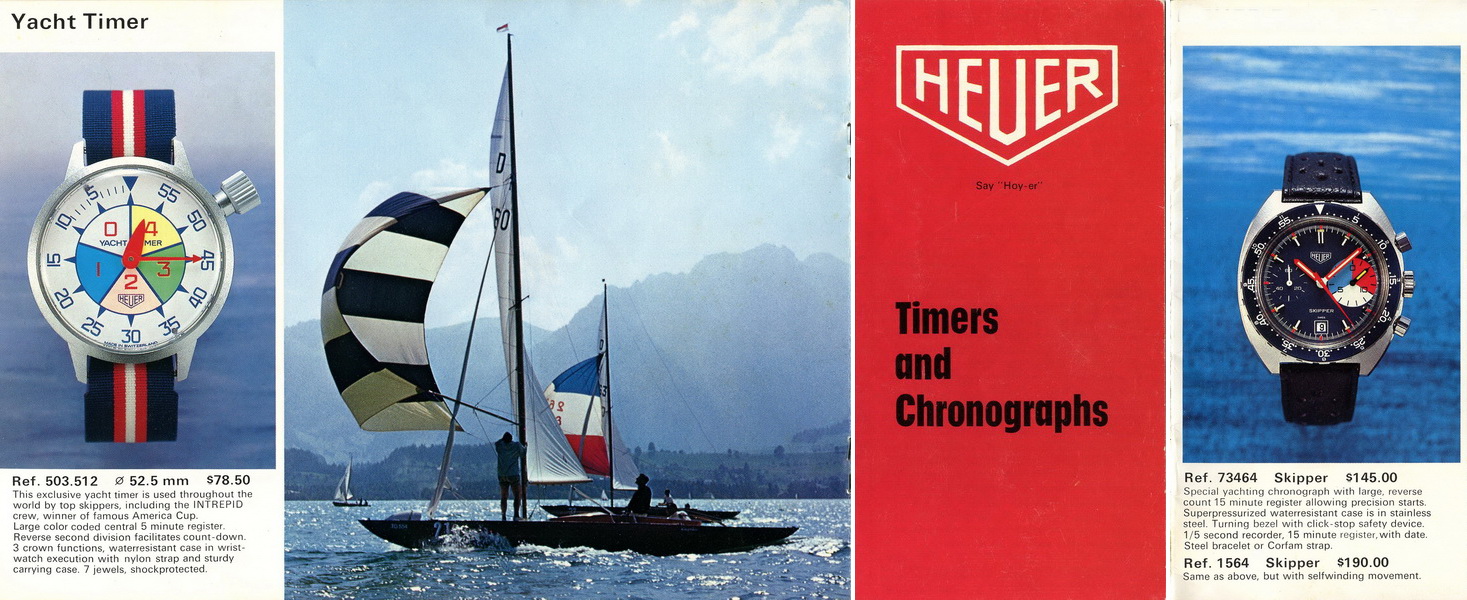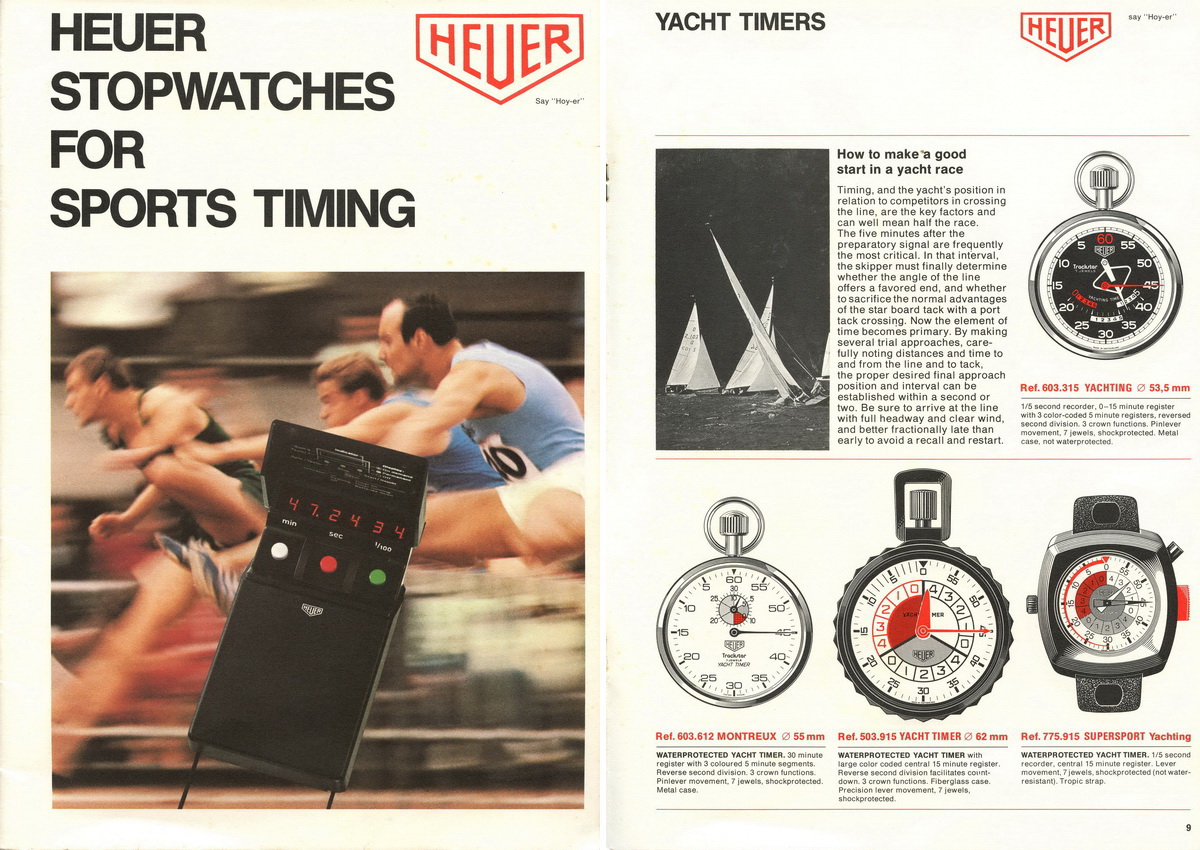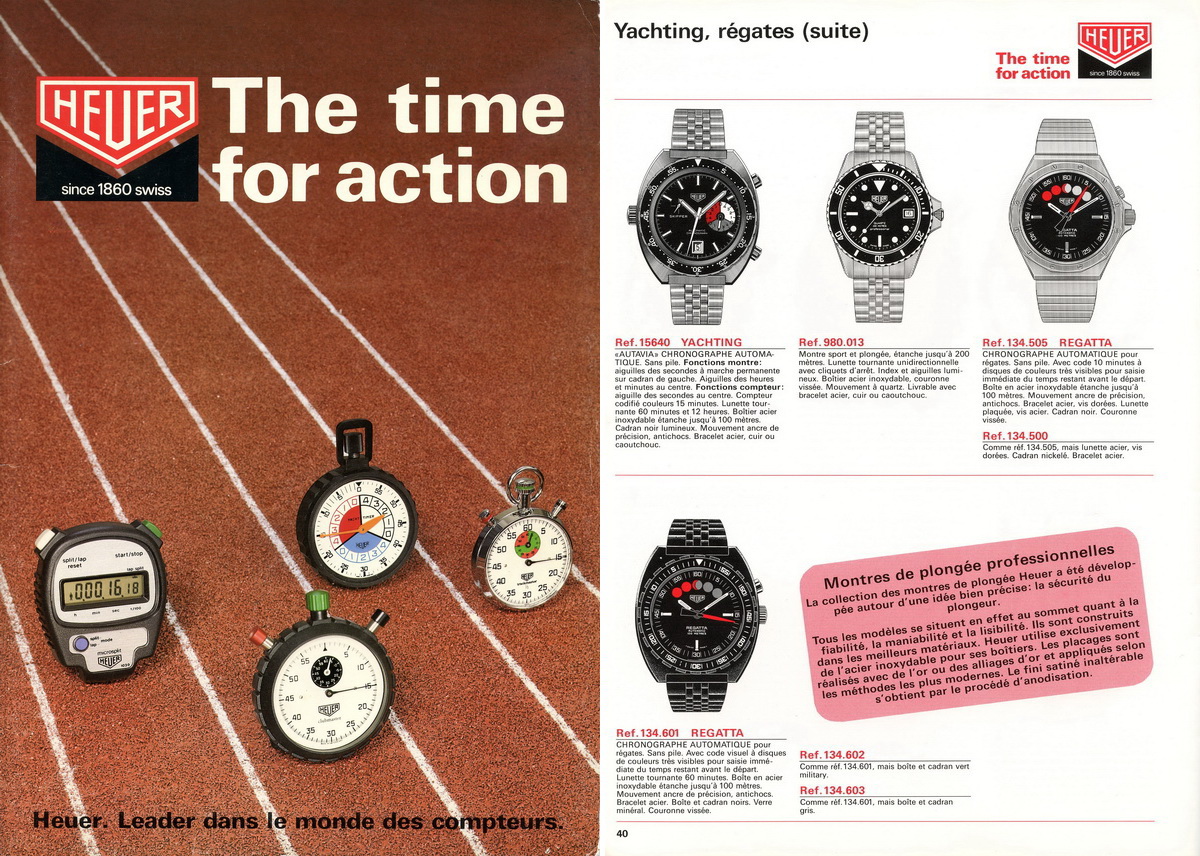Although today’s enthusiasts associate Heuer most closely with motorsports, over the years Heuer developed and marketed a vast array of stopwatches and chronographs for timing all sorts of sports events. Glancing at Heuer’s 1970 /71 catalog of timers and chronographs, we see timepieces for over 40 sports, ranging from bobsledding to boxing, and from and rodeo to rugby.
Many of Heuer’s stopwatches and chronographs were designed for specific sports. For example, for track and field, Heuer recommended a stopwatch with 1/100 second indication, with split action (show, below left). By contrast, the parachutist had far simpler requirements, being well-served by a simple 60 second stopwatch, that is highly legible and reliable in low temperatures. Indeed, the parachutist had no need for even the simplest feature, the time-in and time-out button to stop and restart the watch. The waterski-slalom timer (Reference 403.632) indicates the motorboat’s speed over a measured distance, while the rowing timer (Ref 403.414) shows strokes per minute.
Heuer made split second stopwatches to time the differential between two runners, two horses or two cars, flyback timers to check lap times, and even a chess clock will keep track of the times of the players’ moves.
The Challenges of Yacht Timing
Heuer developed special timepieces for many types of competitions, but yacht races (regattas) presented some unique challenges. First, while timing the race itself is important, the countdown to the start of the race may be even more important. The competitors have a set time before the start of the race (usually 10 minutes), to plot their course / develop their approach to the start line, and the boat that gets to the start line in the best position will be at a significant advantage in the race itself.
Bouncing on the waves, with the sun and spray obstructing the view, legibility will be critical. Bigger will usually be better, especially for the captain reading the countdown to the start of the race. In the minutes before the start of the race, the deck will be a busy place, so simplicity in the design and functions of the watch will also be critical. Of course, let’s not forget that the ideal yacht timer must be waterproof and shock resistant.
This Survey
In this posting, we will survey the yacht timers that Heuer offered over the years from 1959 through 1984. Rather than examining the timepieces themselves, we will review the timepieces that Heuer presented in its catalogs and brochures. We point out that Heuer made certain yacht timers that never appeared in its catalogs. Still, a review of the catalogs provides a good overview of the history of these timepieces.
1959.
Our review of Heuer’s regatta timers begins in 1959, with a catalog that shows only two stopwatches. The Reference 33.712 stopwatch counts down 5 minutes on a central minute register, with a 60 second countdown on the outer track. The Reference 3912 stopwatch takes a different approach, counting down 10 minutes on a small recorder at the top of the dial and counting down 60 seconds on the outer track. The Ref 33.712 has a hoop for a lanyard; the Ref 3912 attaches to a wrist-strap. [Click HERE to see this 1959 catalog.]
1961.
Heuer’s 1961 catalog continues to show two yacht timers, both of them on wrist-straps. The Reference 33.512 stopwatch (successor to the 33.712) counts down 5 minutes on a central dial; the Reference 3912 stopwatch counts down 10 minutes (divided into two 5-minute segments) on a small recorder at the top of the dial. [Click HERE for the entire 1961 catalog.]
1962.
In this two-sided sheet (circa 1962), we see three countdown stopwatches for yacht timing, References 912/5, 912/10 and 912/15. The 5, 10 and 15 designations refer to the number of minutes counted down on the small recorder at the top of the dial. For $2.00, Heuer offers a separate rubber cap, to protect the timers from shock and the water.
Introduced in the late 1940s, the Solunar wristwatch has a colorful dial that indicates the times for the high and low tides for a specific location. In this sheet, we see Heuer positioning the Solunar for the yacht racer.
1963.
In Heuer’s 1963 catalog of timers and chronographs, we see the same three countdown stopwatches as on the sheet from 1962 — References 912/5, 912/10 and 912/15. The “W” in the Reference 912/15W indicates that this stopwatch comes in a waterproof case. The Ref. 33.512 continues as the 5 minute countdown yacht timer worn on a wrist strap. [Additional pages of this catalog are HERE.]
1968
In Heuer’s 1968 catalog, the Reference 503.512 has replaced the Reference 33.512 as 5-minute countdown yacht timer worn on a wrist strap. Whereas the older models looked like stopwatches with hoops attached, the new model looks like an oversized wristwatch.
Heuer had been making dashboard timers since the 1930s, with the Master Time (8 day clock) and Autavia and Monte Carlo (12-hour stopwatches) usually directed to the car racers. In this catalog we see the Navia — essentially a Master Time clock fitted in a new waterproof case — being offered as a yacht timer.
This 1968 catalog offers two stopwatches for yachting. The Reference 403.615 uses a small register at the top of the dial for a 15-minute countdown; the Reference 503.615 uses a central register to show a 15-minute countdown, with this register divided into three 5 minute segments.
1970
Headquartered in Bath, England, with branches in Zurich and New York, Chronosport was one of the largest suppliers of specialty timepieces in Europe. Chronosport’s 1969 / 70 catalog featured specialty timepieces for automobile racing, aviation, boating and watersports, and industrial and scientific timing. The catalog included a broad range of chronographs, stopwatches and dashboard timers from Heuer, as well as specialty watches and chronographs from Breitling, Desotos, Enicar, Seiko and Sicura.
The catalog includes two Heuers in the yacht racing category — a Skipper chronograph and the Reference 503.512 yacht timer.
Introduced in 1968, the Skipper chronographs featured a 15 minute countdown register, that took the place of the customary 30 minute recorder. The first Skippers were housed in Carrera cases, with the 15-minute countdown divided into green, blue and orange segments. The Skippers soon moved to the Autavia cases, however, because of their better waterproofing, and the 15-minute countdown register used red, white and blue segments. This Skipper shown in this catalog uses the same snap-back “compressor” case as Heuer’s Reference 7763 Autavia.
1972.
This 1972 brochure (below) shows a Reference 503.512 Yacht Timer on a wrist-strap, and a Skipper chronograph (Reference 73464) that has moved from the late-1960s style “compressor” case to the 1970s style screw-back case.
The 1972 chronograph catalog (below) shows an automatic version of the Skipper, Reference 15640, powered by the Caliber 15 movement. [Click HERE to see the entire 1972 Chronograph catalog.]
1973.
The timeline in Heuer’s 1973 Stopwatch catalog tells us that Heuer has developed the Supersport, a wrist stopwatch “in an attractive shape” that uses a central register for the minutes, to offer improved legibility.
Inside the catalog, we see four models of the SuperSport (below, on the left-hand page). The Reference 775.915 SuperSport is specifically designated as a Yacht Timer, with a central 15 minute register, marked to count down the minutes in three 5-minute segments. The Reference 775.901 M is a standard 60-minute stopwatch, but the rotating minutes bezel is marked for countdowns. The Supersports operate in an unusual fashion: The crown on the left is for winding the watch. The pusher at 3 o’clock is a three-function crown, that starts, stops and resets the timer on consecutive pushes. The small button on the top right corner (at 2 o’clock) allows the user to resume timing the event (restart), after the watch has been stopped.
Heuer’s 1973 Stopwatch catalog shows another innovation — water-resistant stopwatches in 62 millimeter fiberglass cases (below, on the right-hand page). The Reference 403.915 and Reference 503.915 are larger versions of older models; the Reference 542.912 stopwatch has a jumping disc to countdown the minutes.
[Click HERE to see more of Heuer’s 1973 Stopwatch catalog (in German).]
1976.
We saw the 1950s version of the Solunar watch included in a 1962 listing of Yachting Timers, and this 1976 brochure shows the new version of the Solunar, Reference 279.603. The Solunar from the 1970s is very different from the Solunar of the 1950s, as it shows the tides over a 14-day period, rather than the previous 2-day period. You can see the Instructions for the Solunar HERE.
Alongside the Solunar, we see the Supersport Reference 775.915 yacht timer, featuring a central 15-minute countdown timer, with 5-minute segments marked in the white-blue-red sequence of the regatta flags.
[Click HERE to see the entire Heuer 1976 brochure.]
1977.
Heuer’s 1977 catalog of Stopwatches for Sports Timing features one new stopwatch for yacht timing, the Reference 603.315 (below, top row). This stopwatch has a 15-minute scale toward the center of the watch, with three 5-minute countdown segments.
1978
Heuer’s 1978 chronograph and stopwatch catalog featured three waterproof Yacht Timers. The Reference 503.915 (top row) is in the 62 millimeter fiberglass case, while the Reference 775.915 (bottom row, left) provides the central 15-minute countdown in the Supersport case. As usual, we see one Yacht Timer on a wrist-strap, the Reference 503.512 (bottom right). [Click HERE to see the entire 1978 brochure.]
1980
In this 1980 brochure, we see a change in Heuer’s basic Yacht Timer worn on a wrist-strap. The steel-cased Reference 503.512 stopwatch has been replaced by the fiberglass Reference 203.512 stopwatch. Notice that the smaller Reference 603.615 stopwatch, in a metal case, is listed as an “Economy” model, while the larger Reference 503.915 stopwatch, in a fiberglass case, is described as a “Professional” model.
1982
Heuer’s 1982 Stopwatch catalog shows us a new line of Yacht Timers on wrist-straps. The Reference 203.505 Yacht Timer offers a 5-minute countdown, while the Reference 203.510 (“Surfer” model), provides a 10-minute countdown. The catalog tells us that the central 10-minute register on the Surfer has been designed according to the new International Windsurfing Regatta rules.
The Reference 790 Anemometer measures the speed of the wind, with the catalog telling us that it will be useful for yachting, windsurfing, glider flying, kite flying, track and field, ski-jumping, model airplanes, etc. It incorporates four scales — m/s, km/h, knots and the Beaufort scale.
1983.
Heuer’s 1983 “Time for Action” catalog features 10 timers for yachting — three chronographs and seven stopwatches. In both the chronographs and the stopwatches, we see the return of a feature from Heuer’s yacht timers of the 1960s — colored balls to count down the minutes to the start.
In the mid-1960s, Heuer distributed the full line of Aquastar chronographs, including the Aquastar “Regate” chronograph. The Aquastar Regate used five cut-out circles and colored discs for the 5-minute countdowns, to start the race. Aquastar co-branded these timers for Heuer, so that we saw the Heuer shield at the bottom of the dial with “Aquastar Geneve” across the top. Two decades later, the 1983 Heuer catalog shows two different styles of Regatta chronographs that use these same cut-out circles and colored discs for the countdown. The smaller Ref 134.505 Regatta is in a stainless steel case and the larger Reference 134.601 Regatta uses a PVD-coated borrowed from the Autavias.
In this 1983 catalog, we also see what would be the final version of the Skipper. This Skipper, Reference 15640, borrows its case from the Reference 11063 Autavia, measuring 42.5 mm across the dial and 21 mm between the lugs, with a uni-directional rotating bezel.
The Supersport stopwatches are no longer in the line-up, but Heuer still shows seven stopwatches for yacht timing, four for the wrist and three handheld models.
The Reference 202.515 and 685.915 stopwatches used the same system of cut-out circles and a colored disc for the countdown as we see on the Regatta chronographs. Red circles appear during the first five minutes, white circles over the next five minutes, and the letters S-T-A-R-T over the last five minutes.
The five other stopwatches included in this catalog are continuations of models shown in previous catalogs.
[Click HERE to see more of Heuer’s 1983 Time for Action catalog (in French).]
1984
The Time for Action catalog shows only watches and chronographs, rather than stopwatches and other styles of timers. Accordingly, there are only two types of regatta chronographs, the Reference 134.500 and 505 models (in the smaller cases) and the Reference 134.601, 602 and 603, which use PVD cases, borrowed from the Autavias. All these chronographs use colored discs to countdown the 5-minutes sequences. [See more of the 1984 Time for Action catalog HERE.]
With the 1984 catalog, we have completed our tour of yacht timers offered by Heuer over the 25 years, from 1959 through 1984. Of course, dive watches became the mainstay for TAG Heuer in the 1980s, and the company also continued with its yacht timers, with the next 25 years including a great variety of yacht timers.
The Movements
From the moment I started this page, I was determined that I would keep it simple — no photographs of actual watches, no historical research, no digging into the movements, no discussion of anything other than the catalogs themselves, etc. In other words, if it isn’t found within the four corners of the catalog, then I wasn’t going to present it in this posting.
I remained true to this plan until a couple of days prior to publishing this posting, when I found myself in a conversation with Hans Schrag, about Heuer’s heritage in the yacht timers. Hans asked whether I had included information about the movements; I replied that the posting was limited to the catalog images . . . and within one hour, Hans had provided the following information:
| Reference | Catalog | Movement |
| 202.515 | 1983 | Lem 6000 |
| 203.505 | 1982, 83 | Lem 6000 |
| 203.510 | 1982, 83 | Lem 6000 |
| 203.512 | 1980 | Lam 6000 |
| 33.512 | 1961, 62, 63 | AS 1564 |
| 33.712 | 1959 | AS 1564 |
| 3912 | 1959, 61 | AS 736 |
| 403.615 | 1968 | Val 7700 |
| 403.915 | 1973 | Val 7710 |
| 503.512 | 1968, 72, 73, 78 | Val 7710 |
| 503.615 | 1968 | Val 7710 |
| 503.915 | 1973, 77, 78, 80 | Val 7710 |
| 542.912 | 1973 | Val 7714 |
| 603.315 | 1977 | BF 411 |
| 603.615 | 1980, 82, 83 | BF 411 |
| 653.515 | 1983 | BF 413 |
| 653.915 | 1982, 83 | BF 413 |
| 658.915 | 1983 | BF 412 |
| 775.901, 775.915 (Supersport) | 1973, 76, 77, 78 | Val 7770 |
| 912/5, 912/10, 912/15 | 1962, 63 | AS 736 |
| 73464 Skipper | 1972 | Val 7734 |
| 15640 Skipper | 1972 | Caliber 15 |
| 279.603 Solunar | 1976 | |
| 134.505 Regatta | 1983, 84 | Lem 1345 |
| 134.601 Regatta | 1983, 84 | Lem 1345 |
| Key: AS = A. Schild; BF = Baumgartner Freres; Lem = Lemania; Val = Valjoux | ||
I hope that readers will find this information about the movements useful, even if it takes away from the simple survey of the catalogs.
Additional References
The following are recommended for additional information on Heuer’s yacht timers (regatta chronographs):
- HeuerChrono.com covers the Heuer Skipper chronographs in full detail, but also includes a very good section on the Heuer Yacht Timers.
- Regatta Yachttimers — a website that covers the history and variations of regatta yachttimer watches. The site covers approximately 20 brands of yacht timers, including Heuer and TAG Heuer.
- TAG Heuer Sailing Watches, a posting on Calibre11.com
- An excellent article, in Revolution magazine — Racer’s Edge, The Evolution of the Regatta Chronograph, by Jack Forster
- On his Heuerville blog, Stewart Morley has written an excellent review of his Heuer Regatta, Reference 134.601 (in black PVD). Stewart also provides minute-by-minute photos, showing how the countdown works (August 25, 2014).
- On his HeuerChrono.com blog, Henrik has added a posting covering Heuer’s use of the “5 Dots” countdown display, on its yacht timers.
In the Sea, By the Sea and On the Sea.
I have been collecting Heuer timepieces for 15 years, but it was only in compiling this survey that I realized the great variety of stopwatches and chronographs that Heuer made for yacht timing and the depth of Heuer’s engagement in the sport.
This survey confirms that in addition to the unique tide watches that Heuer made from the 1950s through the 1970s (the Mareographer and Seafarer), and the amazing array of dive watches that TAG Heuer made starting in the 1980s, Heuer was a dominant producer of timepieces that were used “on the sea”, to time yacht races. Just as we see Heuer in every aspect of motorsports, from the driver and navigator, to the pit crew, to the officials managing the race, so too we see Heuer timing just about everything that happens at the sea — from the tides, to the dives and now to the racing yachts.
Once again, the more we learn about Heuer’s heritage in sports timing, the more impressive that heritage becomes.
Jeff Stein
August 17, 2014
(updated August 26, 2014, to add additional references)




















